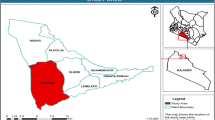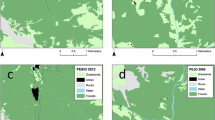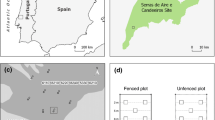Abstract
The river valley of the French upper Meuse and its floodplain, constitutes a relatively natural ecosystem which still contains many endangered species of high conservation value. For example, several birds (Crex crex, Numenius arquata) as well as plant species (Gratiola officinalis, Inula britannica, Teucrium scordium, Ranunculus lingua and Mentha pulegium) which have declined seriously in France in recent times are found in the upper Meuse floodplain. Phytosociological studies and water level measurements have shown that the floristic diversity is mainly influenced by hydrological fluctuations and agricultural practices. The plant communities are structured along a topographical gradient in the high water bed reflecting the duration of floods and the ground water table depth. Agricultural practices have influenced the vegetation changes by selecting species adapted to particular management practices (e.g., fertiliser use, grazing, cutting regime). The data collected in this study from the upper Meuse as enabled 13 grassland and wetland ecotopes to be defined which are correlated with different environmental factors. Fertiliser use, grazing and reduction in the frequency of the cutting lead to a lower species richness because they encourage competitive species. However, it is also demonstrated, that maximum biodiversity is not always synonymous with high conservation value because some impoverished ecosystems, e.g., sedges and tall forb formations, may contain endangered plant and bird species. Knowledge of the boundaries between the different plant communities enables likely changes in floristic composition after modification of one or more site factors to be forecasted. Such factors include, water table depth and flood frequency, cutting regime, fertiliser use and grazing pressure. Thus, the definition of these ecotopes, corresponding to correlations between water regime, agricultural practice and vegetation composition, could lead to the establishment of guidelines for water and agricultural managements that could be involved in restoration projects.
Similar content being viewed by others
References
Auble G.T., Friedman J.M. and Scott M.L. 1994. Relating riparian vegetation to present and future streamflows. Ecol. Applic. 4/3: 544-554.
Bakker J.P., Bekker R.M., Olff H. and Strykstra R.J. 1995. On the role of nutrients, seed bank and seed dispersal in restoration management of fen meadows. Norddeutsche Naturschutz Akademie Berichte 8: 42-48.
Bakker J.P., Poschlod P., Strykstra R.J., Bekker R.M. and Thompson K. 1996. Seed banks and seed dispersal: important topics in restoration ecology. Acta Botanica Neerlandica 45: 461-490.
Barendregt A., De Smidt J.T. and Wassen M.J. 1986. The impact of groundwater flow on wetland communities. In: Colloques Phytosociologiques, XIII, Végétation et Géomorphologie, Bailleul, France, pp. 603-612.
Bekker R. M., Bakker J. P. and Thompson K. 1997. Dispersal of plant species in time and space: can nature development rely on soil seed banks and dispersal? In: Species Dispersal and Land Use Processes. pp. 247-255.
Berendse F., Oomes M.J.M., Altena H.J. and Elberse W.T.H. 1992. Experiments of restoration of species-rich meadows in the Netherlands. Biol. Conserv. 62: 59-65.
Bobe V. 1987. Etude phyto-écologique, agronomique et dynamique des prairies et des friches herbacées des vallées du Parc Naturel Régional de la Haute Vallée de Chevreuse. D.A.A, I.N.A. Paris Grignon, 90 pp.
Bournérias M., Delpech R., Dorigny A., Géhu J.M., Lecointe A., Maucorps J., Provost M., Solau J.L., Tombal P. and Wattez J.R. 1978. Les groupements de prairies et leurs satellites dans la vallée inondable de l'Oise. In: Colloques Phytosociologiques, V, Les prairies humides. Lille, France, pp. 90-139.
Boutin C. and Keddy P.A. 1993. A functional classification of wetland plants. J. Veget. Sci. 4: 591-600.
Broyer J. 1991. Conservation des écosystèmes agricoles dans le Val de Saône et dans la Dombes: Définition de normes de gestion. Ministère de l'Environnement, 122 pp.
Broyer J. 1994. La régression du Râle de Genêts Crex Crex en France et la gestion des milieux prairiaux. Alauda 62: 1-7.
Broyer J. and Prudhomme J. 1995. Incidence de la fertilisation sur la diversité floristique des prairies de fauche inondables dans le val de Saône. Ecologie 26: 45-58.
Carbiener R. 1969. Le grand Ried d'Alsace, Ecologie d'un paysage. Bull. Soc. Industr. Mulhouse 734: 15-44.
De Foucault B. 1984. Systémique, structuralisme et synsystématique des prairies hygrophiles des plaines atlantiques françaises. Thesis, Rouen, France.
Delpech R. 1989. Effets d'une eutrophisation du sol sur la dynamique de populations végétales et la diversité spécifique de communautés herbacées. Résultats expérimentaux. Vème colloque national, L'écologie en France, Des recherches aux applications: Vers de nouvelles perspectives, pp. 151-170.
Denny P. 1993. Water managment strategies for the conservation of wetlands. J. IWEM 7: 387-394.
Dierssen K. 1989. Evolution des groupements influencés par la nappe phréatique de la plaine du N-W de l'Allemagne. Conséquences pour les mesures d'exploitation extensives et de déprise agricole. In Colloque Phytosociologique, XVI, Phytosociologie et Pastoralisme, Paris, France, pp. 484-496.
Duvigneaud J. 1958. Contribution à l'étude des groupements prairiaux de la plaine alluviale de la Meuse lorraine. Bull. Soc. Royal. Botan. Belgique 91: 7-77.
Elberse W.T.H., Van Den Bergh J.P. and Dirven J.G.P. 1983. Effects of use and mineral supply on the botanical composition and yield of old grassland on heavy-clay soil. Netherlands J. Agricult. Sci. 31: 63-88.
Faber M. 1994. Contribution à l'étude hydroclimatique de la Meuse de sa source à la station de Stenay. Mémoire de maîtrise, Nancy, France, 76 pp.
Gordon I-J., Duncan P., Grillas P. and Lecomte T. 1990. The use of domestic herbivores in the conservation of the biological richness of European Wetlands. Bull. Ecol. 21 (3): 49-60.
Grandet G. 1996. Etude écologique des prairies de la zone inondable de l'Ill dans le cadre de leur gestion conservatoire 'article 19'. DEA Sciences Agronomiques, Univ. de Metz-INPL Nancy, France, 50 pp. (+ annex).
Grévilliot F. 1996. Les écosystèmes prairiaux de la plaine alluviale de la Meuse lorraine: Phytosociologie, dynamique et fonctionnement, en relation avec les gradients hydriques et les modifications des pratiques agricoles, Thesis, Univ. Metz, France, 217 pp.
Grévilliot F. and Muller S. 1995a. Application de l'analyse diachronique globale à l'étude de l'évolution d'une végétation prairiale. Comptes Rendus Acad. Sci. Paris 318: 491-497.
Grévilliot F. and Muller S. 1995b. Les groupements végétaux prairiaux de la plaine alluviale de la Meuse Lorraine, France. Position syntaxonomique et biogéographique dans le cadre ouest-européen. 37 th IAVS Symposium, Large area vegetation surveys, Bailleul, France, pp. 115-144.
Grévilliot F. and Muller S. 1997. Etude de l'impact des changements des pratiques agricoles sur la biodiversité végétale dans les prairies inondables du Val de Meuse: Présentation méthodologique et premiers résultats. Acta Bot. Gallica 143: 317-338.
Grévilliot F., Krebs L. and Muller S. 1999. Comparative importance and interference of hydrological conditions and soil nutrient gradients in floristic biodiversity in flood meadows. Biodiv. Conserv. 7: 1495-1520.
Grime J.P. 1979. Plant strategies and vegetation processes. John Wiley and Sons, Chichester, UK, 216 pp.
Grime J.P. and Hunt R. 1975. Relative growth rate: its range and adaptive significance in a local flora. J. of Ecol. 63: 393-422.
Grootjans A.P. and Ten Klooster, W.P.H. 1980. Changes of groundwater regime in wet meadows. Acta Bot. Neerl. 5/6: 546-554.
Guinochet M. 1973. Phytosociologie. Masson, Paris, France, 227 pp.
Harmand D. 1992. Histoire de la vallée de laMeuse Lorraine. Presse universitaire de Nancy, France, 146 pp.
Hercent J.L. 1991. Application de l'Article 19 en vallées de la Meuse, Thinte et Loison. DESS, INPL, Univ. Metz, France, 25 pp. (+ annex).
Krebs L., Corbonnois J. and Muller S. 1999. The impact of hydrological fluctuations on shallow groundwater hydrochemistry under two alluvial meadows. Hydrobiologia 410: 195-206.
Krebs L. 2000. Fonctionnement hydrochimique et biogéochimique d'un écosystème prairial inondable soumis à différentes pratiques agricoles. Exemple des prairies alluviales de la Meuse dans le secteur de Stenay, Thesis, Univ. Metz, France, 257 pp.
Lambinon J., De Langhe J.E., Delvosalle L. and Duvigneaud J. 1992. Nouvelle flore de la Belgique, du G-D du Luxembourg, du Nord de la France et des régions voisines. Ed. du patrimoine du Jardin botanique Nationel de Belgique, 4ème édition, 1092 pp.
Mc Janet C.L., Keddy P.A. and Pick F.R. 1995. Nitrogen and phosphorous tissue concentrations in 41 wetland plants: a comparison across habitats and functional groups. Funct. Ecol. 9: 231-238.
Magnanon S. 1991. Contribution à l'étude des prairies naturelles inondables des marais de Donges et de l'estuaire de la Loire. Phyto-écologie, Phytosociologie, valeur agronomique. Thesis, univ. de Nantes, France, 269 pp.
Matches A.G. 1992. Plant Respons to Grazing: A Review. J. Prod. Agric. 5: 1-7.
Mountford J-O., Lakhani K-H. and Holland R-J. 1996. Reversion of grassland vegetation following the cessation of fertilizer application. J. Veget. Sci. 7: 219-228.
Muller S. 1992. Analyse synchronique des successions végétales après déprise agricole dans les vallées des Vosges du Nord. Ann. Sci. Réserve Biosph. Vosges du Nord 2: 53-67.
Olff H. 1992. Effects of light and nutrient availability on dry matter and N allocation in six successional grassland species. Oecologia 89: 412-421.
Oomes M.J.M. 1992. Yield and species density of grasslands during restoration management. J. Veget. Sci. 3: 271-274.
Osbornova J., Kovarava M., Leps J., Prach K. and Fassatiava O. 1990. Dynamics of populations and communities. In: Succession in abandonned fields. Studies in central Czechoslovakia, Geobotany 15, Kluwer Acad. Press, Dordrecht, The Netherlands, pp. 25-61.
Pautou G. 1975. Contribution à l'étude écologique de la plaine alluviale du Rhône entre Seyssel et Lyon. Thesis, Univ. de Médecine, Grenoble, France, 375 pp.
Plantureux S., Bonischot R. and Guckert A. 1992. Utilisation d'une typologie des prairies permanentes du Plateau Lorrain pour le diagnostic agronomique. Fourrages 132: 381-394.
Poschlod P., Bakker J., Bonn S. and Fischer S. 1996. Dispersal of plants in fragmented landscapes. Changes of dispersal processes in the actual and historical man-made landscape. In: Settle J., Margules C., Poschlod P. and Henle P. (eds.), Species Survival in Fragmented Landscapes. Kluwer Acad. Press, Dordrecht, The Netherlands, pp. 123-127.
Prach K. 1993. Vegetational changes in a wet meadow complex, South Bohemia, Czech Republic. Folia Geobot. Phytotax. (Praha) 28: 1-13.
Sélinger-Looten R. 2000. Déterminisme de la biodiversité des formations herbacées alluviales du bassin versant de la Sarre. Thesis, Univ. Metz, France, 398 pp.
Sélinger-Looten R., Grévilliot F. and Muller S. 1999. Structure of plant communities and landscape patterns in alluvial meadows of two flood plains in the north-east of France. Landsc. Ecol. 14: 213-229.
Smith R.S. and Jones L. 1991. The phenology of mesotrophic grassland in the Pennine Dales, Northern England: Historic hay cutting dates, vegetation variation and plant species phenologies. J. Appl. Ecol. 28: 42-59.
Thomet P. and Koch B. 1993. Langfristige Auswirkungen von Düngung und Schnittregime auf eine Heumatte. Landwirtschaft Schweiz 6: 107-114.
Tiner R.W. 1991. The concept of hydrophyte for wetland identification. Bioscience 41: 236-247.
Tiner R.W. 1993. Using plants as indicator of wetland. Proc. Acad. Nat. Sci. Philadelphia 144: 240-253.
Trivaudey M.J. 1995. Contribution à l'étude phytosociologique des prairies alluviales de l'Est de la France (Vallées de la Saône, de la Seille, de l'Ognon, de la Lanterne et du Breuchin). Approche systémique. Thesis, Univ. de Besançon, 2 vol.
Van der Valk A.G. and Davis C.B. 1981. Succession in wetlands: A gleasonian approach. Ecology 62: 688-696.
Van Diggelen R., Grootjans A.P., Wierda A., Burkunk R. and Hoogendoorn J. 1991. Prediction of vegetation changes under different hydrological scenarios. Proc. of the Vienna symposium, IAHS 202: 71-79.
Van Diggelen R., Grootjans A.P. and Wierda A. 1995. Hydro-Ecological Landscape Analysis: A Tool forWetland Restoration. Zeitschr. Kulturtechn. Landentwick. 36: 125-131.
Vincent V. 1997. Etude de l'impact des modifications des pratiques agricoles sur la végétation des prairies inondables de la Nied. Premiers résultats. D.E.A. Sciences Agronomiques, Univ. de Metz-INPL Nancy, France, 40 pp. (+ annex).
Willems J.H., Peet R.K. and Bik L. 1993. Changes in chalk grassland structure and species richness resulting from selective nutrient additions. J. Veget. Sci. 4: 203-212.
Willms W.D. and Quinton D.A. 1995. Grazing effects on germinable seeds on the fescue prairie. J. Range Manag. 48: 423-430.
Wilson S.D. and Tilman D. 1993. Plant competition and resource availibility in response to disturbance and fertilization. Ecology 74: 599-611.
Author information
Authors and Affiliations
Rights and permissions
About this article
Cite this article
Grevilliot, F., Muller, S. Grassland ecotopes of the upper Meuse as references for habitats and biodiversity restoration: A synthesis. Landscape Ecology 17 (Suppl 1), 19–33 (2002). https://doi.org/10.1023/A:1015225609385
Issue Date:
DOI: https://doi.org/10.1023/A:1015225609385




